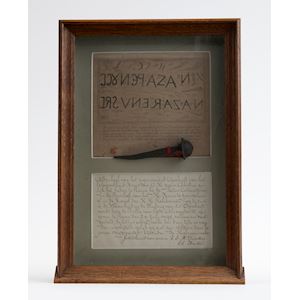
14 Reliquary frame with a nail from the Cross
You are now looking at a reliquary frame that contains a nail and an inscription. The notice below the nail, says the inscription is a replica of the one on the Cross. That inscription is now preserved in Rome. According to the Gospel of John, Pontius Pilate had an inscription nailed above Christ’s head. It read ‘Jesus of Nazareth, the King of the Jews’ and it was written in three languages – Hebrew, Latin, and Greek. Curiously not only the Hebrew, but also the Latin and the Greek are written from right to left. The Empress Helena, who found the inscription together with the True Cross, donated one part to Constantinople, one part to Jerusalem and one part to Rome. Relics are fragments of the remains of saints, or objects related to saints. There are various types of relic. First-degree relics are the bodies or body parts of saints, such as bones, teeth, nails, and blood. Second-degree relics are items or objects that saints have touched during their lifetime; the relics of Christ’s Passion are also an example of this. And finally, third-degree relics are objects that have touched the saint’s body after his or her death. During the Middle Ages, the veneration of relics became so widespread and so obsessive that it frequently led to abuses. This made the practice controversial. The Catholic Church forbids trading in first and second-degree relics, but it does allow trading in third-degree relics, as long as the trade is supervised by the ecclesiastical authorities and is done under an oath of authenticity. Relics are a powerful devotional aid. They are an enduring reminder of what used to be. But they are also a proof, a pointer to a knowledge of the past and from there also to the present.


PARCUM
In our museum you will find thematic exhibitions at the confluence of religion, art and culture. Exhibitions that bring you face to face with the often unseen heritage of our churches, abbeys and monasteries. In today's multi-religious and highly diverse society, particular attention is paid here to promoting dialogue. Our exhibitions do not provide answers; they encourage thinking and dialogue. PARCUM is much more than a museum. It is also a visit to one of the best preserved abbey complexes in the Benelux.
- PARCUM
- Heverlee Belgium
- +32 (0)16 40 60 73
- www.parcum.be
